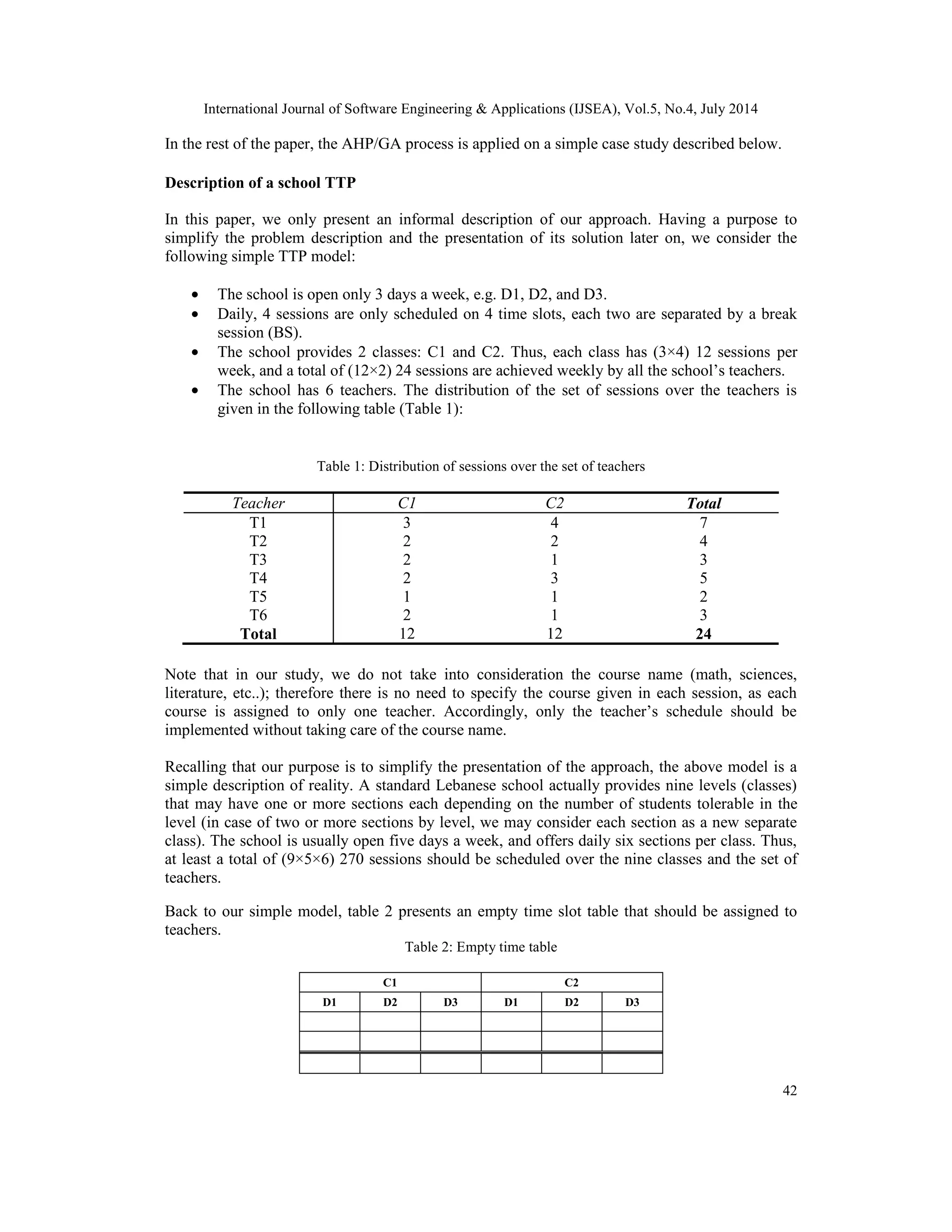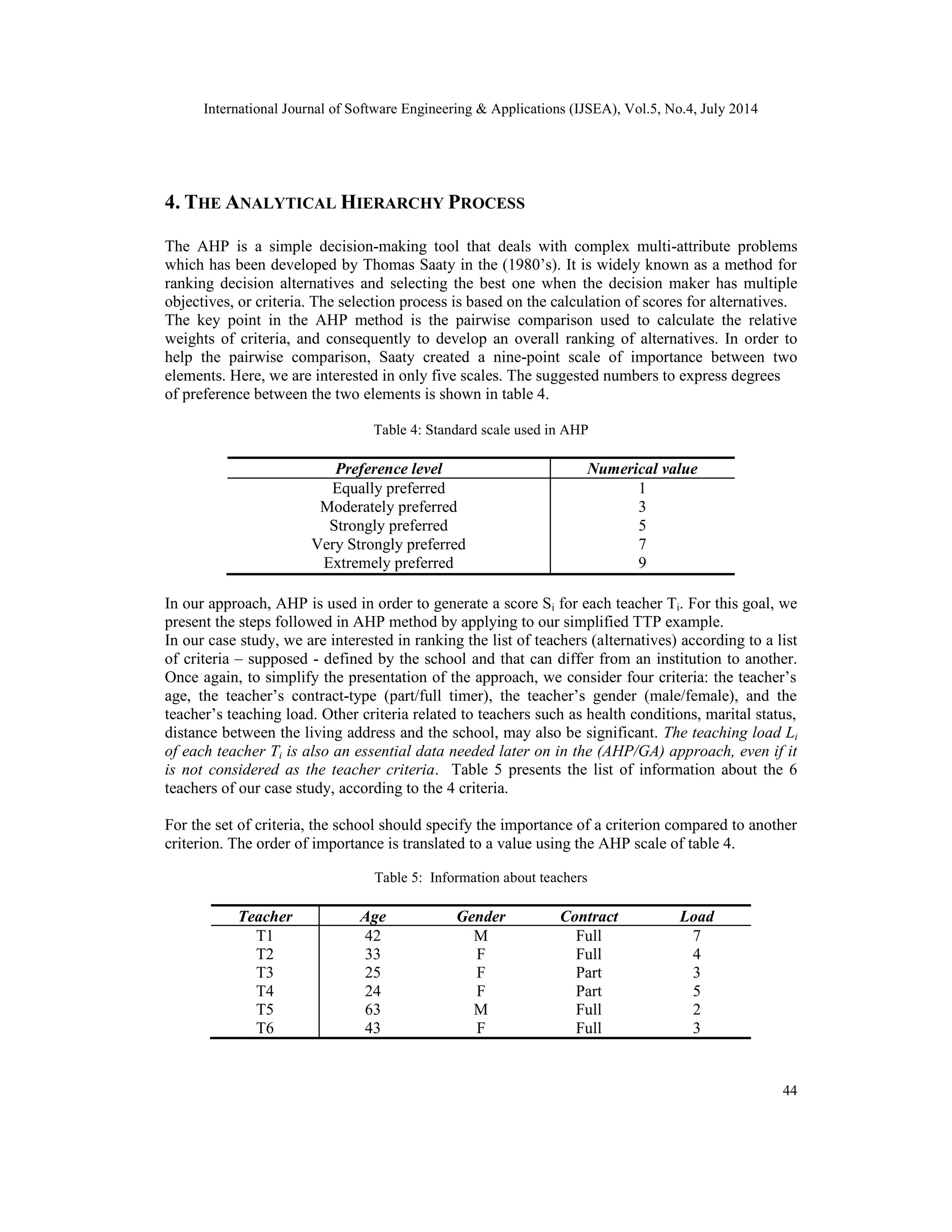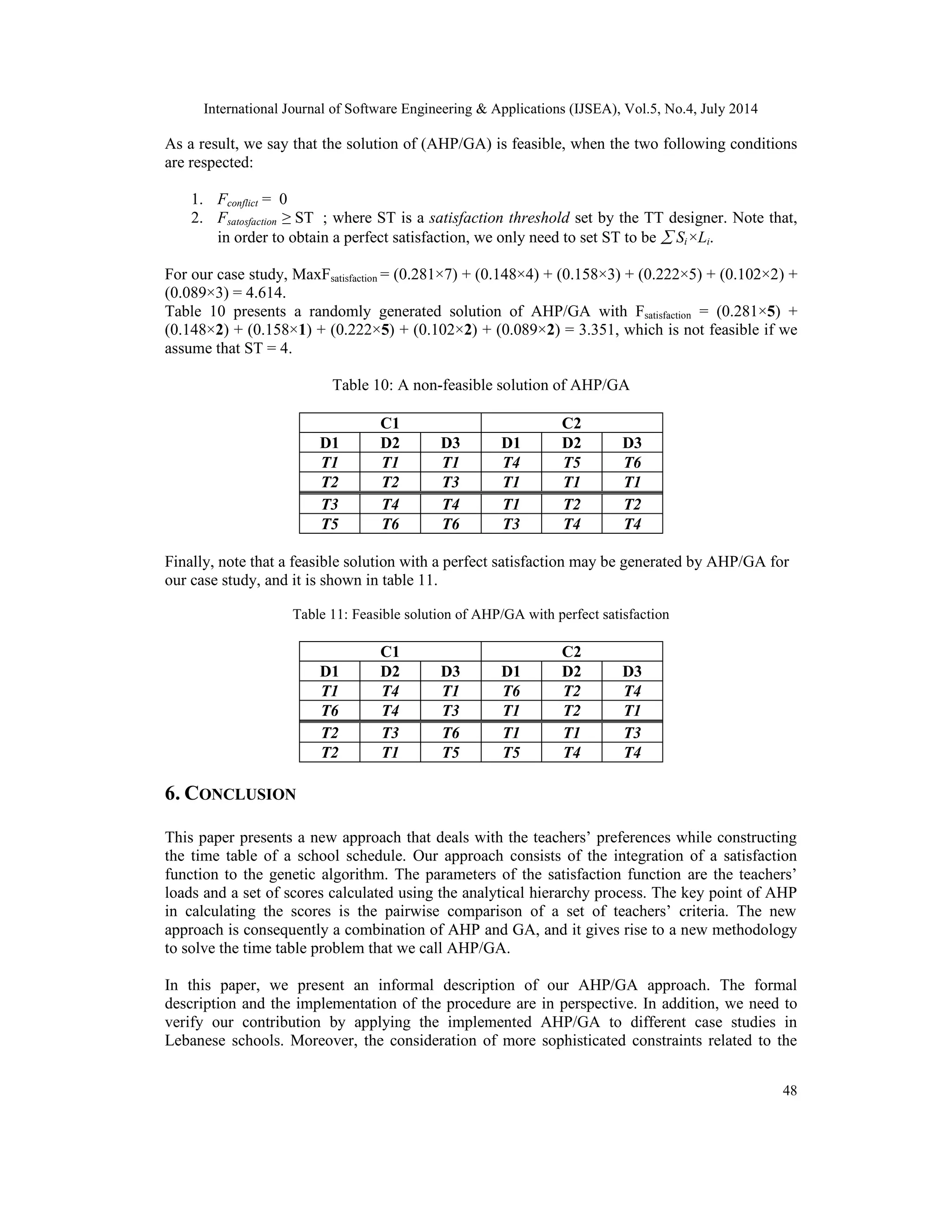This document describes a new approach that combines the analytical hierarchy process (AHP) and genetic algorithm (GA) to solve the timetable problem in schools. AHP is used to rank teachers based on criteria and assign a score to each teacher. GA is then used to generate timetable schedules that aim to satisfy teacher preferences, with the fitness function considering teacher scores from AHP. The approach was tested on a simple example of scheduling classes and teachers across days and time slots. By incorporating teacher rankings and preferences, the AHP/GA approach aims to produce timetables that satisfy teachers more than existing manual or automated methods.
![International Journal of Software Engineering & Applications (IJSEA), Vol.5, No.4, July 2014
DOI : 10.5121/ijsea.2014.5403 39
COMBINING THE ANALYTICAL HIERARCHY
PROCESS AND THE GENETIC ALGORITHM TO
SOLVE THE TIMETABLE PROBLEM
Ihab Sbeity, Mohamed Dbouk and Habib Kobeissi
Department of Computer Sciences, Faculty of Sciences, Section I, Lebanese University,
LEBANON
ABSTRACT
The main problems of school course timetabling are time, curriculum, and classrooms. In addition there
are other problems that vary from one institution to another. This paper is intended to solve the problem of
satisfying the teachers’ preferred schedule in a way that regards the importance of the teacher to the
supervising institute, i.e. his score according to some criteria. Genetic algorithm (GA) has been presented
as an elegant method in solving timetable problem (TTP) in order to produce solutions with no conflict. In
this paper, we consider the analytic hierarchy process (AHP) to efficiently obtain a score for each teacher,
and consequently produce a GA-based TTP solution that satisfies most of the teachers’ preferences.
KEYWORDS
Timetable problem, Genetic algorithm, Analytic Hierarchy process, and Multi-criteria decision making.
1. INTRODUCTION
The timetable problem (TTP) is the process of scheduling a sequence of courses between
teachers, students and rooms, to satisfy a set of various constraints. These constraints differ based
on the institutions involved, e.g. schools, universities, and so on.
In some institutions, such as Lebanese elementary schools and high-schools, an important
constraint to consider is the teacher preferences that may be related to some criteria, such as the
teacher age, his address, his contract-type, etc. For example, a teacher with seniority should have
the opportunity to choose his course schedule. Or, a part-time teacher has the priority to select his
preferred schedule over a full-time teacher, and so on. Some of these criteria may be a reflection
of the social life and relationships in the urban Lebanese institutions. Note that, these criteria may
be conflicting so that the ranking of teachers accordingly becomes not obvious. This is, for
example, the case when comparing a senior full-time teacher with a younger part-time teacher.
The analytic hierarchy process (AHP), developed by Saaty [1], is an effective tool for dealing
with such complex decision making processes; therefore building a ranking relationship between
teachers, based on a series of pairwise comparisons. In addition, the AHP incorporates a useful
technique for checking the consistency of the decision evaluation, hence reducing the bias in the
decision making process.
On the other hand, the manual solution of TTP is still used nowadays, for reasons related, not
only to the lack of budget needed to buy a dedicated TTP solver such that aSc [2, 3] and Prime](https://image.slidesharecdn.com/combiningtheanalyticalhierarchy-140813061623-phpapp01/75/Combining-the-analytical-hierarchy-1-2048.jpg)
![International Journal of Software Engineering & Applications (IJSEA), Vol.5, No.4, July 2014
40
[4], but also to the inconsistency of such tools with the Lebanese teachers’ criteria. With the
majority of existing tools, the person responsible in creating the schedule must manually specify
the teachers’ priorities with their -inconsistent-preferences, and then the tool will generate the
timetable schedule. However, the teachers’ priorities are not always evident to be significantly
measured. In addition, as TTP is an NP-complete problem, its manual solution is time and effort-
consuming. The problem would be presented by a great number of variables which make it
intractable. That was the motivation to approach it by means of Genetic Algorithm (GA) [5].
In this paper, we present a new approach (AHP/GA) that combines AHP and GA to create a time
table schedule that matches most of the teachers’ preferences along with the institution. Using
AHP, we will develop a teachers ranking by providing a score for each teacher, and then, a
satisfaction function will be incorporated to the GA to produce the schedule that matches as best
the AHP ranking, and satisfies of most the teachers’ preferences. An informal description of the
approach is presented basing on a simple example. The formal description and the
implementation of the method would be our future challenge.
The rest of this paper is structured as follows: Section 2 presents a background of works related to
the utilization of GA to solve TTP. Section 3 describes the steps followed by AHP/GA to
produce a time table schedule taking into consideration the teachers’ preferences. We also present
a simple case study to be an application of the procedure. In section 3, AHP is applied to a set of
teachers and their score calculation procedure is presented. Section 4 describes the result of the
combination of AHP and GA to generate the time table schedule. Section 5 concludes our paper
and describes our ongoing works.
2. BACKGROUND
2.1. Genetic algorithm
A genetic algorithm is a type of searching algorithm. It searches a solution space for an optimal
solution to a problem. The key characteristic of the genetic algorithm is how the searching is
done. The algorithm creates a “population” of possible solutions to the problem and lets them
“evolve” over multiple generations to find better and better solutions. The population is the
collection of candidate solutions that we are considering during the course of the algorithm. Over
the generations of the algorithm, new members are “born” into the population, while others “die”
out of the population. A single solution in the population is referred to as an individual. A fitness
function of an individual presents a measure of how “good” the solution represented by the
individual is. The better the solution, the higher the fitness – obviously, this is dependent on the
problem to be solved.
The selection process is analogous to the survival of the fittest in the natural world. Individuals
are selected for “breeding” (or cross-over) based upon their fitness values –the fitter the
individual, the more likely that individual will be able to reproduce. The cross-over occurs by
mingling the two solutions together to produce two new individuals. During each generation,
there is a small chance for each individual to mutate, which will change the individual in some
small way [6]. For further information about GA, refer to [7].
2.2. Related works
Various types of timetable problems appear with regards to educational institutions and depend
on the elements to be scheduled, i.e. exams or regular courses. An excellent survey of exam
timetabling techniques is presented in Qu et al. [8]. The examination timetabling is similar in](https://image.slidesharecdn.com/combiningtheanalyticalhierarchy-140813061623-phpapp01/75/Combining-the-analytical-hierarchy-2-2048.jpg)
![International Journal of Software Engineering & Applications (IJSEA), Vol.5, No.4, July 2014
41
most institutions and consists of scheduling the exams for a set of courses, over a limited time
period, while avoiding the overlapping of the exams for each student, as well as seeking the
largest spread over the examination period [9].
However, the course timetable differs regarding to the institution, i.e. universities, schools. A
course timetable scheduling problem basically deals with effective distribution of five kinds of
entities (or resources): Rooms, Courses, Teachers, Students, and Time (days and hours).
In university timetables, the problem presents a large number of constraints to be satisfied. These
constraints typically cover the time conflict, the room conflict, the course conflict, and other
criteria related to teachers and students preferences. Commonly, they are divided into two types:
hard constraints and soft constraints [10]. Hard constraints are those that cannot be violated, such
as: “no more than one course is allowed at a timeslot in each room.” Soft constraints may be
violated, but the purpose lies in minimizing their violation. An example of soft constraints in a
university timetable is: “a student can only attend one course per day”. A wave of works had
proposed GA-based solutions for the university timetable problem; we underline the works of
[10, 11, 12].
The schools TTP may be defined as a subset of the universities TTP, as in university TTP the
number of set of constraints is larger. Several works has addressed the school TTP and presented
different approaches to solve the problem; we highlight the works of [8, 13, 14]. Each of these
works proposes a different utilization and definition of GA parameters (chromosomes description,
mutation and crossover definition, etc). Other works apply a parallel implementation of GA to
solve the school TTP [15]. However, addressing the teachers’ preferences in the way presented by
this paper has never been previously carried out, and it would be our contribution.
3. THE AHP/GA PROCESS AND PROBLEM DESCRIPTION
A common classic definition of the GA fitness function presented by previous works [13, 14, 15,
16] takes into consideration the time conflict. Hence, our AHP/GA approach assumes that the
time conflict is already solved by using one of the fitness functions previously mentioned. Our
concern is to consider the teachers’ preferences such that a feasible solution is the one that
satisfies the most of these preferences. The AHP/GA process is described by figure 1.
First, AHP is used to calculate the score of each teacher arising from a set of information given
according to the institution valuable criteria. These scores are considered as one of the GA input.
The fitness function of the GA is practically composed of two functions: the conflict function and
the satisfaction function. A feasible solution should be validated by both functions; however, we
omit the process used by the conflict function as it may be the same as in one of previous
mentioned works. The satisfaction function, having the teachers’ scores as parameters, checks if
the GA produced solutions satisfy the teachers’ preferences given as input.
Figure 1: the AHP/GA process](https://image.slidesharecdn.com/combiningtheanalyticalhierarchy-140813061623-phpapp01/75/Combining-the-analytical-hierarchy-3-2048.jpg)



![International Journal of Software Engineering & Applications (IJSEA), Vol.5, No.4, July 2014
45
We consider that the contract type and the teacher load are the most important factors that give
the teacher the superiority to choose his/her preferred schedule. A part-timer teacher has primacy
over a full-timer. Also, the teacher with greater load should be prioritized over a teacher with a
smaller load.
The teacher’s age comes next in the importance of criteria. Ages are divided into 5 intervals: I1 =
[21 - 30], I2 = [31 - 40], I3 = [41 - 50], I4 = [50 - 60] and I5 = [60 – and up]. Intervals of older
ages become more important in the preference level, e.g. older teachers are given the priority to
choose their course schedule over younger teachers. Teachers of the same age interval have the
same preference value.
The teacher’s gender has the least importance in the preference order. We assume that a “female”
teacher has the priority in the preference level.
According to the AHP scale of table 4, and the relative importance of criteria described above, the
pairwise comparison rating for each criterion is given in table 6.
Table 6: Pairwise comparison for the four criteria
Age
Teacher T1 T2 T3 T4 T5 T6
T1 1 3 5 5 1/5 1
T2 1/3 1 3 3 1/7 1/3
T3 1/5 1/3 1 1 1/9 1/5
T4 1/5 1/3 1 1 1/9 1/5
T5 5 7 9 9 1 5
T6 1 3 5 5 1/5 1
Gender
Teacher T1 T2 T3 T4 T5 T6
T1 1 1/3 1/3 1/3 1 1/3
T2 3 1 1 1 3 1
T3 3 1 1 1 3 1
T4 3 1 1 1 3 1
T5 1 1/3 1/3 1/3 1 1/3
T6 3 1 1 1 3 1
Load
Teacher T1 T2 T3 T4 T5 T6
T1 1 3 5 3 5 5
T2 1/3 1 3 1 3 3
T3 1/5 1/3 1 1/3 1 1
T4 1/3 1 3 1 3 3
T5 1/5 1/3 1 1/3 1 1
T6 1/5 1/3 1 1/3 1 1
Contract type
Teacher T1 T2 T3 T4 T5 T6
T1 1 1 1/5 1/5 1 1
T2 1 1 1/5 1/5 1 1
T3 5 5 1 1 5 5
T4 5 5 1 1 5 5
T5 1 1 1/5 1/5 1 1
T6 1 1 1/5 1/5 1 1
As per the criterion “AGE”, we consider that the ascending exploration of intervals correspond to
a same exploration in the preference scale. Thus, the age of the interval I3 is “strongly preferred”
to the age of I2, and “moderately preferred” to the age of I1, and so on. As an example, the
pairwise comparison of T1 to T3 gives the value 5 meaning that the age of T1 (42) is strongly
preferred to the age of T3 (24).
The pairwise comparison according to the criterion “gender” respects the fact that a female is
moderately preferred to a male teacher. The pairwise comparison of the criterion “contract-type”
is achieved according to the fact that a part-timer is strongly preferred to a full-timer. Finally, we
applied the pairwise comparison of the “load” criteria, again, basing on a division of the load
value into intervals [0-2[, [2-4[, [4-6[, [6-..[, and the same strategy used for the criterion “age” is
applied.](https://image.slidesharecdn.com/combiningtheanalyticalhierarchy-140813061623-phpapp01/75/Combining-the-analytical-hierarchy-7-2048.jpg)

![International Journal of Software Engineering & Applications (IJSEA), Vol.5, No.4, July 2014
47
The third step of AHP is ranking the criteria to determine their relative importance or weights.
Again, the pairwise comparison is used for this purpose.
Agreeing with the relative importance previously described, table 9 shows the criteria’ weights
which are calculated in a similar way as the preference vectors.
Table 9: Criteria's weights
Criteria Age Gender Load Contract Weight
Age 1 3 1/5 1/3 0.122
Gender 1/3 1 1/7 1/5 0.057
Load 5 7 1 3 0.558
Contract 3 5 1/3 1 0.263
Total 28/3 16 176/105 68/15
Now, the score of each teacher may be calculated as a vector/matrix multiplication of the weight
of table 9 and the matrix of table 8. The obtained result is as follows:
• S1 = Score T1 = (0.193×0.122) + (0.072×0.057) + (0.420×0.558)+(0.071×0.263) = 0.281
• S2 = Score T2 = 0.148
• S3 = Score T3 = 0.158
• S4 = Score T4 = 0.222
• S5 = Score T5 = 0.102
• S6 = Score T6 = 0.089
The set of score S = {Si, i = 1 ... 6} will be used in the next section to incorporate an overall
satisfaction function to the GA in order to produce the requested time table satisfying most of the
teachers’ preferences.
Finally, we mention that AHP also incorporates a useful technique for checking the consistency
of the decision evaluation. A consistency test may be applied to our study to verify if the
considered pairwise comparisons are reliable. For further information about the consistency test,
refer to [13].
5. COMBINING AHP AND GA (AHP/GA)
As it has been presented, the genetic algorithm proposes a fitness function used to test the
feasibility of a produced solution. The classic fitness function of a GA applied to solve the TTP
takes into consideration the time conflict. We define this function by Fconflict. Practically, Fconflict
may return the number of conflicts in the generated solution and a solution if feasible when the
value of Fconflict is 0 [15]. This task is implemented by several previous works.
In our (AHP/GA) approach, another function Fsatisfaction – the satisfaction function- is integrated to
the GA fitness function, such that Fsatisfaction = Si×Mi. Where Si, is the score of teacher Ti
generated by AHP, and Mi is the number of sessions of teacher Ti that match its preferred
schedule (see table 3). Observe that the maximum value of Fsatisfaction (called MaxFsatisfaction) is
Si×Li, where Li is the load of Ti, and hence we obtain a perfect satisfaction.](https://image.slidesharecdn.com/combiningtheanalyticalhierarchy-140813061623-phpapp01/75/Combining-the-analytical-hierarchy-9-2048.jpg)

![International Journal of Software Engineering & Applications (IJSEA), Vol.5, No.4, July 2014
49
courses order, and their integration into AHP/GA is another important perception. The declaration
of a set of rules, for the manual interception while building the time table, is also suitable.
REFERENCES
[1] Saaty, T.L., ‘The Analytic Hierarchy Process’, McGraw-Hill, Inc., 1980.
[2] Mockus, Jonas, and Lina Pupeikienė. "On multi-start algorithms for optimization of high school
timetables." Informatica 23.3 (2012): 405-425.
[3] The aSc timetable tool official website: http://www.asctimetables.com
[4] The Prime timetable tool, official website: http://www.primetimetable.com
[5] Holland, John H. "Genetic algorithms and the optimal allocation of trials." SIAM Journal on
Computing 2.2 (1973): 88-105.
[6] S. M. Thede, “An introduction to genetic algorithms,” J. Comput. Sci. Colleges, vol. 20, no. 1, pp.
115–123, Oct. 2004.
[7] Goldberg, David Edward. "Genetic algorithms in search, optimization, and machine learning". Vol.
412. Reading Menlo Park: Addison-wesley, 1989.
[8] Qu R, EK Burke, B McCollum, LTG Merlot, SY Lee. "A survey of search methodologies and
automated system development for examination timetabling." Journal of scheduling 12.1 (2009): 55-
89.
[9] Gyori, Sándor, Zoltán Petres, and Annamária R. Várkonyi-Kóczy. "Genetic Algorithms in
Timetabling. A New Approach." Budapest University of Technology and Economics, Hungary
(2001).
[10] Ghaemi, Sehraneh, Mohammad Taghi Vakili, and Ali Aghagolzadeh. "Using a genetic algorithm
optimizer tool to solve University timetable scheduling problem." Signal Processing and Its
Applications, 2007. ISSPA 2007. 9th International Symposium on. IEEE, 2007.
[11] Abdullah, Salwani, and Hamza Turabieh. "Generating university course timetable using genetic
algorithms and local search." Convergence and Hybrid Information Technology, 2008. ICCIT'08.
Third International Conference on. Vol. 1. IEEE, 2008.
[12] Chaudhuri, Arindam, and Kajal De. "Fuzzy genetic heuristic for university course timetable problem."
International journal of Advance Soft Computing Application 2.1 (2010).
[13] Colorni, Alberto, Marco Dorigo, and Vittorio Maniezzo. "A genetic algorithm to solve the timetable
problem." Politecnico di Milano, Milan, Italy TR (1992): 90-060.
[14] Dhanabalan, K., S. Nagarajan, and S. Sakthivel. "Genetic Algorithm based Timetabling System-New
Approach." International Journal of Research & Reviews in Computer Science 1.2 (2010).
[15] Abramson, David, and J. Abela. "A parallel genetic algorithm for solving the school timetabling
problem". Division of Information Technology, CSIRO, 1991.
[16] Carrasco, Marco P., and Margarida V. Pato. "A multiobjective genetic algorithm for the class/teacher
timetabling problem." Practice and Theory of Automated Timetabling III. Springer Berlin
Heidelberg, 2001. 3-17.
Authors
Ihab Sbeity, the main author, is Associative Professor in Computer Science at the Faculty
of Sciences in the Lebanese University. He received a Maîtrise in applied mathematics
from the Lebanese university, a Master in computer science - systems and communications
from Joseph Fourier University, France, and a PhD from INPG (Institut National
Polytechnique de Grenoble), France. His PhD works are related to Performance Evaluation
and System Design. Actually, his research interests include software performance engineering, UML
modelling, and decision information system.](https://image.slidesharecdn.com/combiningtheanalyticalhierarchy-140813061623-phpapp01/75/Combining-the-analytical-hierarchy-11-2048.jpg)
